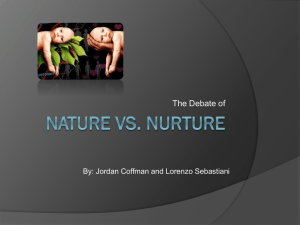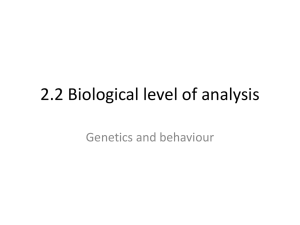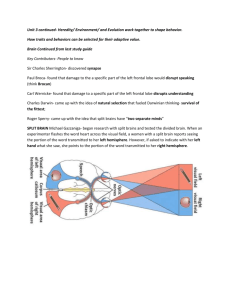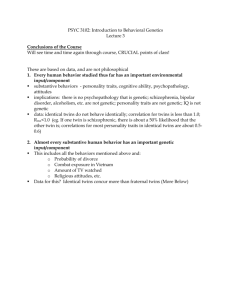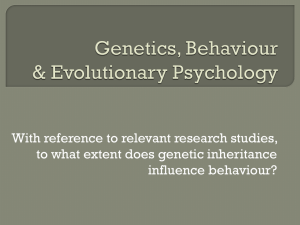here
advertisement
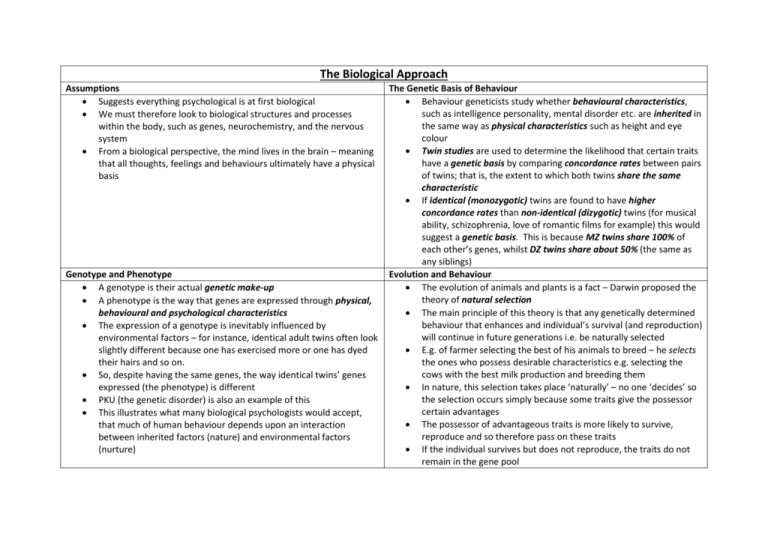
The Biological Approach Assumptions Suggests everything psychological is at first biological We must therefore look to biological structures and processes within the body, such as genes, neurochemistry, and the nervous system From a biological perspective, the mind lives in the brain – meaning that all thoughts, feelings and behaviours ultimately have a physical basis Genotype and Phenotype A genotype is their actual genetic make-up A phenotype is the way that genes are expressed through physical, behavioural and psychological characteristics The expression of a genotype is inevitably influenced by environmental factors – for instance, identical adult twins often look slightly different because one has exercised more or one has dyed their hairs and so on. So, despite having the same genes, the way identical twins’ genes expressed (the phenotype) is different PKU (the genetic disorder) is also an example of this This illustrates what many biological psychologists would accept, that much of human behaviour depends upon an interaction between inherited factors (nature) and environmental factors (nurture) The Genetic Basis of Behaviour Behaviour geneticists study whether behavioural characteristics, such as intelligence personality, mental disorder etc. are inherited in the same way as physical characteristics such as height and eye colour Twin studies are used to determine the likelihood that certain traits have a genetic basis by comparing concordance rates between pairs of twins; that is, the extent to which both twins share the same characteristic If identical (monozygotic) twins are found to have higher concordance rates than non-identical (dizygotic) twins (for musical ability, schizophrenia, love of romantic films for example) this would suggest a genetic basis. This is because MZ twins share 100% of each other’s genes, whilst DZ twins share about 50% (the same as any siblings) Evolution and Behaviour The evolution of animals and plants is a fact – Darwin proposed the theory of natural selection The main principle of this theory is that any genetically determined behaviour that enhances and individual’s survival (and reproduction) will continue in future generations i.e. be naturally selected E.g. of farmer selecting the best of his animals to breed – he selects the ones who possess desirable characteristics e.g. selecting the cows with the best milk production and breeding them In nature, this selection takes place ‘naturally’ – no one ‘decides’ so the selection occurs simply because some traits give the possessor certain advantages The possessor of advantageous traits is more likely to survive, reproduce and so therefore pass on these traits If the individual survives but does not reproduce, the traits do not remain in the gene pool Scientific Methods P: One strength of the Biological approach is that it uses scientific methods of investigation. E: For example, it gathers information of an individual using fMRI scanning techniques, family and twin studies. E: This is a strength because the techniques are highly precise and highly scientific. This means that studies have increased validity and reliability as the techniques (such as fMRI) can be repeated successfully. L: As a result, the credibility of the biological approach is increased. Evaluation of the Biological Approach Real-life Application Deterministic P: One strength of the Biological approach is that it has real-life application. E: For example, the increased understanding of biochemical processes in the brain has led to the development of psychoactive drugs that treat serious mental illnesses, such as depression. E: This is a strength for the biological approach because it means that sufferers are able to manage their condition and live a relatively normal life, rather than remain in hospital. Although these drugs are not effective for all patients, they have revolutionised treatment for many. L: Consequently, the credibility of the Biological approach is increased. P: However, one weakness of the biological approach is that it is deterministic. E: For example, it states that human behaviour is governed by internal, biological causes (such as genes) that we have no control over. E: While this is good in potential reallife application such as in courts in helping to convict criminals (such as if there was a criminal gene), it fails to discuss the act of free will and choosing NOT to commit criminal behaviour for example, or being influenced by the environment i.e. poverty making people commit crimes such as theft. L: As a result, the credibility of the biological approach is reduced.


